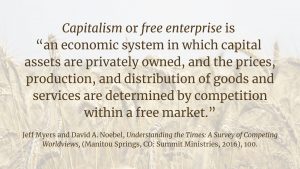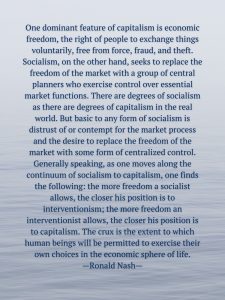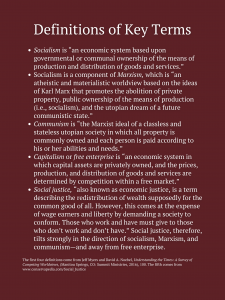Say: Let’s define some key terms at the outset. Go here for a page displaying these definitions. Return to Session 1 by going here.
-
- Socialism is “an economic system based upon governmental or communal ownership of the means of production and distribution of goods and services.”2
- Socialism is “an economic system based upon governmental or communal ownership of the means of production and distribution of goods and services.”2

-
- Socialism is a component of Marxism, which is “an atheistic and materialistic worldview based on the ideas of Karl Marx that promotes the abolition of private property, public ownership of the means of production (i.e., socialism), and the utopian dream of a future communistic state.”3

-
- Communism is “the Marxist ideal of a classless and stateless utopian society in which all property is commonly owned and each person is paid according to his or her abilities and needs.”4

Explain that the “ideal” of a “stateless” and “classless” society is impossible to achieve. In communist countries, the state becomes god and two classes of people exist: the tyrannical dictators who live in luxury and the property stricken population of the country. People own nothing; the state owns and runs everything. the people are slaves of the state.
-
- Capitalism or free enterprise is “an economic system in which capital assets are privately owned, and the prices, production, and distribution of goods and services are determined by competition within a free market.”5

-
- Social justice, “also known as economic justice, is a term describing the redistribution of wealth supposedly for the common good of all. However, this comes at the expense of wage earners and liberty by demanding a society to conform. Those who work and have must give to those who don’t work and don’t have.” Social justice, therefore, tilts strongly in the direction of socialism, Marxism, and communism—and away from free enterprise. In an earlier post, we explored five ways social justice and biblical justice are opposing ideals.

-
- Another term we eventually will consider is interventionism. Although consideration of this term not slated for the first session but the second, we still are offering a brief discussion of it, as well as digital graphics showcasing it, here. The late Ronald Nash, a Christian theology professor with broad expertise in philosophy and culture, wrote the following.
One dominant feature of capitalism is economic freedom, the right of people to exchange things voluntarily, free from force, fraud, and theft. Socialism, on the other hand, seeks to replace the freedom of the market with a group of central planners who exercise control over essential market functions. There are degrees of socialism as there are degrees of capitalism in the real world. But basic to any form of socialism is distrust of or contempt for the market process and the desire to replace the freedom of the market with some form of centralized control. Generally speaking, as one moves along the continuum of socialism to capitalism, one finds the following: the more freedom a socialist allows, the closer his position is to interventionism; the more freedom an interventionist allows, the closer his position is to capitalism. The crux is the extent to which human beings will be permitted to exercise their own choices in the economic sphere of life.

With the exception of interventionism, all of the above terms and their definitions are presented in the following graphic.

top image credit: Photo by Romain Vignes on Unsplash
This page is part of a larger article.
Copyright © 2021 by B. Nathaniel Sullivan. All rights reserved.
